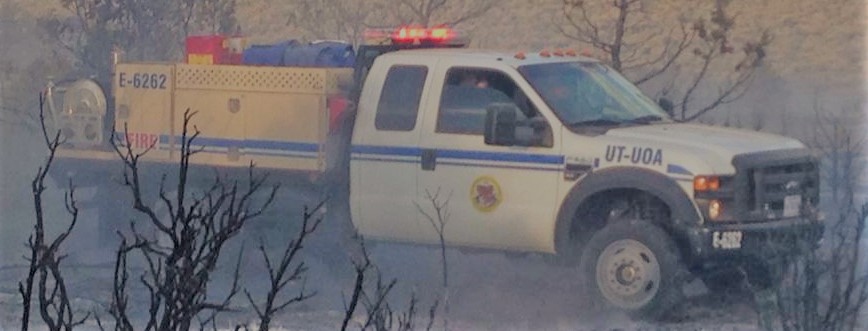Wildland Fire Engine Program

The BIA has over 200 engines that—along with dozers, water tenders, and heavy equipment—contribute to fire suppression efforts in Indian Country. Firefighters who staff these engines make up engine crews. They are the backbone of Indian Country’s wildfire response workforce.
Engine crews are made of three to seven firefighters working together to respond to wildfires across Indian Country. Crew members are taught how to safely drive and use heavy water-filled trucks in remote areas to put fires out by spraying water and constructing handline to keep wildfires from spreading. Crewmembers are familiar with how to draft and pump water using various equipment and are experts in packing backpacks to quickly lay out hoses to deliver water to remote areas.
Firefighters on engine crews start out as Engine Operators (ENOPs) and work their way up to engine bosses (ENGB), who then become engine strike team leaders (STEN). These leaders may oversee two to five engines at a time during wildfire operations.
Driving Requirements
All BIA employees occupying positions requiring operation of a vehicle must successfully complete the web-based National Safety Council driving course, "Defensive Driving" every three years. In addition, BIA requires all personnel who drive a government vehicle to take BL-300 Basic Drivers Course.
Engine Operator Certification and Training
In March, 2019, the BIA Wildland Fire Management Program began implementing training and experience requirements for personnel who operate wildland fire engines on behalf of the BIA.
Because of the responsibilities driving fire engines entails, BIA requires firefighters who operate wildland fire engines to have and carry valid state driver’s license certification. Fire program managers also ensure their engine personnel are aware of state laws and are appropriately licensed, prior to operating any wildland fire engine.
Certification
Firefighters must certify as engine operators (ENOP) before becoming an engine boss (ENGB). ENGB’s who have an open task book will also need to certify as ENOPs by January, 2021 before earning their ENGB certification.
These requirements provide wildland fire engine personnel training and job experience that teaches firefighters how to safely and expertly drive, operate, and tactically use BIA wildland fire engines.
Engine Training
N-9018 Engine Operator Training
The N-9018 Engine Operator Training covers inspecting, driving, pump operations, maintenance, winterizing, emergency driving policy and multiple tactical use scenarios. It is taught at the unit level by instructors who are certified as Type 4 Incident Commanders (ICT4) and Engine Bosses (ENGB).
BIA Fire Management staff require all second-year and onward engine personnel, including Administratively Determined (AD) firefighters, take the N-9018 course to ensure the safety of engine personnel and other firefighters working around them. Portable Pumps and Water Use (S-211) is also required to further their knowledge and understanding of water use and handling.
Download the N-9018 course material.
Lights and Sirens Training
In addition to taking the web-based National Safety Driving Course, BL-300, S-211 and N-9018, all personnel who plan to operate wildland fire engines must take a training course on the use of emergency lights and sirens. This course is in accordance with individual state laws and BIA’s Standard Operating Procedures.
Lights and Sirens Training Material is under development as of March, 2019.
Motor Vehicle Policy Information
- 2019 Fire Vehicle Driver Orientation Course Requirement
- 2019 Engine Operator Position and Curriculum, Lights and Sirens Training, and Licensing for Wildland Fire Engine Operation
- 2011 Amended PD for Indian Affairs Employees
- 2010 Motor Vehicle Operator Eligibility Form
- 2010 Motor Vehicle Operation Policy, Responsibilities, Implementation & Procedures
- 2009 Executive Order 13513 - Reducing Text Messaging While Driving
- 2009 BIA Motor Vehicle Policy Memo
- GSA-3607 MV License & Driving Record
- SF-91
- SF-95
Additional Information
Additional Resources
Contact Us
Boise, ID 83705


